APE1/Ref-1 interacts with NPM1 within nucleoli and plays a role in the rRNA quality control process
- PMID: 19188445
- PMCID: PMC2655621
- DOI: 10.1128/MCB.01337-08
APE1/Ref-1 interacts with NPM1 within nucleoli and plays a role in the rRNA quality control process
Abstract
APE1/Ref-1 (hereafter, APE1), a DNA repair enzyme and a transcriptional coactivator, is a vital protein in mammals. Its role in controlling cell growth and the molecular mechanisms that fine-tune its different cellular functions are still not known. By an unbiased proteomic approach, we have identified and characterized several novel APE1 partners which, unexpectedly, include a number of proteins involved in ribosome biogenesis and RNA processing. In particular, a novel interaction between nucleophosmin (NPM1) and APE1 was characterized. We observed that the 33 N-terminal residues of APE1 are required for stable interaction with the NPM1 oligomerization domain. As a consequence of the interaction with NPM1 and RNA, APE1 is localized within the nucleolus and this localization depends on cell cycle and active rRNA transcription. NPM1 stimulates APE1 endonuclease activity on abasic double-stranded DNA (dsDNA) but decreases APE1 endonuclease activity on abasic single-stranded RNA (ssRNA) by masking the N-terminal region of APE1 required for stable RNA binding. In APE1-knocked-down cells, pre-rRNA synthesis and rRNA processing were not affected but inability to remove 8-hydroxyguanine-containing rRNA upon oxidative stress, impaired translation, lower intracellular protein content, and decreased cell growth rate were found. Our data demonstrate that APE1 affects cell growth by directly acting on RNA quality control mechanisms, thus affecting gene expression through posttranscriptional mechanisms.
Figures
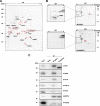

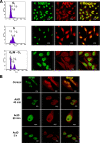

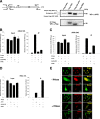
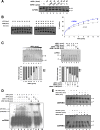
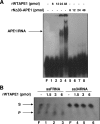
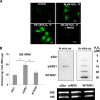


Similar articles
-
Nucleolar accumulation of APE1 depends on charged lysine residues that undergo acetylation upon genotoxic stress and modulate its BER activity in cells.Mol Biol Cell. 2012 Oct;23(20):4079-96. doi: 10.1091/mbc.E12-04-0299. Epub 2012 Aug 23. Mol Biol Cell. 2012. PMID: 22918947 Free PMC article.
-
Nucleophosmin interaction with APE1: Insights into DNA repair regulation.DNA Repair (Amst). 2020 Apr;88:102809. doi: 10.1016/j.dnarep.2020.102809. Epub 2020 Jan 30. DNA Repair (Amst). 2020. PMID: 32092641
-
Inhibitors of the apurinic/apyrimidinic endonuclease 1 (APE1)/nucleophosmin (NPM1) interaction that display anti-tumor properties.Mol Carcinog. 2016 May;55(5):688-704. doi: 10.1002/mc.22313. Epub 2015 Apr 11. Mol Carcinog. 2016. PMID: 25865359 Free PMC article.
-
Intrusion of a DNA repair protein in the RNome world: is this the beginning of a new era?Mol Cell Biol. 2010 Jan;30(2):366-71. doi: 10.1128/MCB.01174-09. Epub 2009 Nov 9. Mol Cell Biol. 2010. PMID: 19901076 Free PMC article. Review.
-
Emerging roles of the nucleolus in regulating the DNA damage response: the noncanonical DNA repair enzyme APE1/Ref-1 as a paradigmatical example.Antioxid Redox Signal. 2014 Feb 1;20(4):621-39. doi: 10.1089/ars.2013.5491. Epub 2013 Sep 21. Antioxid Redox Signal. 2014. PMID: 23879289 Free PMC article. Review.
Cited by
-
Saccharomyces cerevisiae Apn1 mutation affecting stable protein expression mimics catalytic activity impairment: implications for assessing DNA repair capacity in humans.DNA Repair (Amst). 2012 Sep 1;11(9):753-65. doi: 10.1016/j.dnarep.2012.06.008. Epub 2012 Jul 19. DNA Repair (Amst). 2012. PMID: 22818187 Free PMC article.
-
Fine-tuning nucleophosmin in macrophage differentiation and activation.Blood. 2011 Oct 27;118(17):4694-704. doi: 10.1182/blood-2011-03-341255. Epub 2011 Aug 29. Blood. 2011. PMID: 21876121 Free PMC article.
-
Targeted mRNA oxidation regulates sunflower seed dormancy alleviation during dry after-ripening.Plant Cell. 2011 Jun;23(6):2196-208. doi: 10.1105/tpc.111.086694. Epub 2011 Jun 3. Plant Cell. 2011. PMID: 21642546 Free PMC article.
-
Quantitative proteomics and dynamic imaging of the nucleolus reveal distinct responses to UV and ionizing radiation.Mol Cell Proteomics. 2011 Oct;10(10):M111.009241. doi: 10.1074/mcp.M111.009241. Epub 2011 Jul 21. Mol Cell Proteomics. 2011. PMID: 21778410 Free PMC article.
-
Serum AP-endonuclease 1 (sAPE1) as novel biomarker for hepatocellular carcinoma.Oncotarget. 2019 Jan 8;10(3):383-394. doi: 10.18632/oncotarget.26555. eCollection 2019 Jan 8. Oncotarget. 2019. PMID: 30719231 Free PMC article.
References
-
- Andersen, J. S., Y. W. Lam, A. K. L. Leung, S. E. Ong, C. E. Lyon, A. I. Lamond, and M. Mann. 2005. Nucleolar proteome dynamics. Nature 43377-83. - PubMed
-
- Apicelli, A. J., L. B. Maggi, Jr., A. C. Hirbe, A. P. Miceli, M. E. Olanich, C. L. Schulte-Winkeler, A. J. Saporita, M. Kuchenreuther, J. Sanchez, K. Weilbaecher, and J. D. Weber. 2008. A non-tumor suppressor role for basal p19ARF in maintaining nucleolar structure and function. Mol. Cell. Biol. 281068-1080. - PMC - PubMed
-
- Beernink, P. T., B. W. Segelke, M. Z. Hadi, J. P. Erzberger, D. M. Wilson III, and B. Rupp. 2001. Two divalent metal ions in the active site of a new crystal form of human apurinic/apyrimidinic endonuclease, Ape1: implications for the catalytic mechanism. J. Mol. Biol. 3071023-1034. - PubMed
-
- Bellacosa, A., and E. G. Moss. 2003. RNA repair: damage control. Curr. Biol. 13R482-R484. - PubMed
Publication types
MeSH terms
Substances
Grants and funding
LinkOut - more resources
Full Text Sources
Molecular Biology Databases
Research Materials
Miscellaneous
